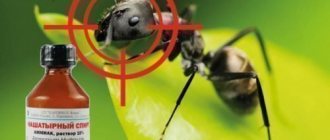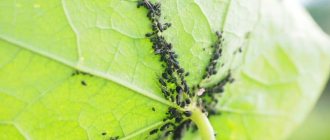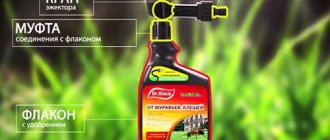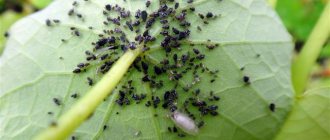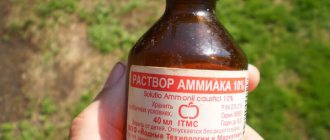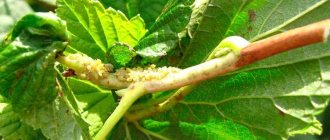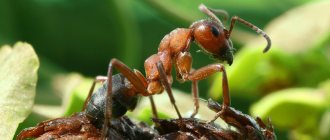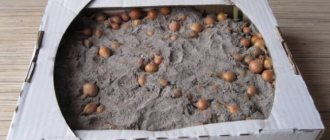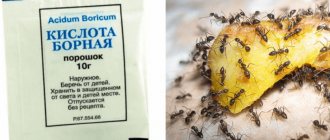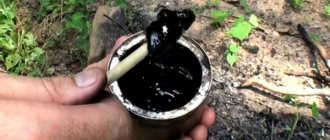Ants are not as harmless as they might seem when you read about them in fairy tales and fables. Farmers know that, having settled in the garden or garden, these little hard workers cause serious damage to the crop. If they get into the house, it will become even more difficult to deal with them. The modern chemical industry is ready to provide highly effective means to combat insect pests. However, these drugs are also unsafe for other insects, such as bees that pollinate plants, as well as for humans and their pets. Many gardeners seek to solve the problem with folk remedies. One of them is an aqueous solution of ammonium hydroxide. Ammonia helps get rid of ants in the garden without posing a danger to others. It is only important to know how to use it correctly.
Ammonia - a little chemistry
Ammonia is one of the most important products of the chemical industry; it is used in various areas of human activity.
It is also used to obtain ammonia. The fundamental difference between these products is that ammonia is a gaseous substance that liquefies at -33°C. Ammonia gas or “alkaline air” was obtained in 1774 by the English scientist J. Priestley. The chemical composition of the new substance was determined in 1785, at which time it received its name. There are several assumptions about where this name came from. One of them is associated with the name of the ancient Egyptian god Amon. During ritual ceremonies, believers sniffed ammonia, a white crystalline substance that releases ammonia when heated. The second version is the existence of the Ammon oasis in North Africa, located at the intersection of busy caravan routes. The constant presence of a large number of pack animals on its territory led to the accumulation of their waste products. Under the influence of high temperature, urea emits a pungent ammonia odor.
Ammonia Ammonia is an aqueous solution of ammonia, or rather ammonium hydroxide. In appearance it is a colorless transparent liquid with a pungent odor.
On a note!
In addition to its medical purposes, the product is often used by summer residents while working in the garden. This is explained by the fact that plants need nitrogen to actively grow green mass, set buds and form fruits. In ammonia, its mass reaches 82% of the total composition of the drug.
The high concentration of the alcohol solution, low price and cost-effectiveness of use are the factors that explain the high demand for the pharmaceutical product, as confirmed by consumer reviews.
What is ammonia?
Ammonia is a substance in the form of a gas. It turns into a liquid substance at a temperature of minus thirty-three. It was discovered by the outstanding chemist, philosopher and priest Joseph Prisley in 1774. At that time it was called alkaline air.
The production of the substance has two versions of its origin:
- named after the God Amun. According to this version, during the ceremonies, the ministers sniffed crystals, which at high temperatures emitted a pungent odor;
- in honor of the oasis of Amun, which was located along the caravan route in North Africa. After resting, the camels left an unpleasant odor after urinating. When accumulated, it gave off an ammonia aroma.
Ammonia is ammonia hydroxide in liquid form, a so-called aqueous solution. It has no color and has a very pungent aroma. This product is used for disinfection if a person has lost consciousness and is also a pain reliever.
This product is used to repel insects in the house or garden due to the fact that its smell is very unpleasant for them.
Ammonia has several advantages in use, such as:
- Affordable price.
- Saving.
- No harm to the human body.
Let's celebrate! The effect of using such a drug has been evident for years, as a large number of people leave their reviews and the results of using such a substance.
Why are ants dangerous?
Ammonia will not completely get rid of ants. It is almost impossible to eliminate these insects.
But by controlling their numbers, it will be possible to protect the harvest and create a comfortable atmosphere in the house. First, you need to understand how dangerous colonies of these insects are.
Ants in the garden
There are more than 14 thousand species of ants in the world. More than 260 species are distributed in Russia. Insects cause irreparable damage to garden crops, leading to a decrease in yield.
By making passages underground, small insects damage plant roots. Vegetable seedlings and young tree seedlings react particularly sensitively to the fruits of their vital activity.
Ants are predatory insects. But they do not disdain young leaves of seedlings and adult plants.
Ants on raspberries
Insects with a sweet tooth are not averse to eating sweet juicy raspberries and strawberries, as well as plums, apricots and other fruits. As a result, they become unsuitable for further storage.
Ants often settle in old stumps, contributing to their natural destruction. This behavior is undoubtedly beneficial.
Anthill on an old stump
But an increase in their population leads to the fact that small insects begin to colonize new places, choosing healthy trees as shelters. By gnawing tunnels in them, they destroy the wood, causing the death of the tree.
But the greatest danger to garden crops is aphids, which ants carry on their backs. Aphids secrete sugary juice - the favorite food of working insects.
Ants and aphids
Therefore, they transfer their food source from plant to plant, infecting the entire garden. Using ammonia against ants will also help get rid of aphids.
Ants in the house
Being very small and agile, ants can climb into living spaces. It is necessary to begin a merciless fight against the pest after detecting one individual - the scout ant.
Ant trail
Several factors contribute to this:
- Having a sting, ants can bite humans and animals;
- bites cause the development of allergic reactions;
- insect pests are carriers of many infectious diseases;
- Being omnivores, they spoil food by getting into bags of sugar, jars of honey and other food storage areas.
Insects cause concern to all inhabitants of the house. In just one night they are capable of completely destroying a small animal (turtle, hamster, etc.).
You can also read our article: How to quickly get rid of yellow ants, the best control methods
What harm do ants cause?
Harm in the home
If you find at least one ant in the house, you should prepare in advance for the fact that you will soon see their paths. They are mainly located in hard-to-reach places. The dimensions of such an insect are at least two and a half millimeters.
In fact, they are very dangerous for the home, as evidenced by the following:
- They are carriers of infections, as their movements begin from garbage cans and end with food on the table.
- Their bites can be dangerous and lead to allergic reactions in the body.
- Ants are very fond of sweets, so when they reproduce, they will constantly appear in foods such as honey or sugar. Such food cannot be consumed for consumption, so food spoilage can also be attributed to the harm of such insects.
- They can lay eggs in the fur of animals and thereby put the pet in a restless state (bites, scabies and other diseases).
Harm in the garden
The presence of ants in the garden also leads to damage. All paths are open to them and they can penetrate anywhere.
They cause the following harm:
- Yield level. When moving, ants dig their way, thereby damaging the root system of the plant, especially for very young seedlings, since their roots are still very weak.
- Plant leaves. Insects eat the leaves, causing the seedlings to suffer damage.
- Spoilage of fruits. Such insects love sweet harvests. This most likely applies to fruit trees. After this, the fruits become unsuitable for consumption.
- Ants dig tunnels and the tree bark becomes loose. This can lead to the emergence of new, more serious pests.
Also, ants are interested in the appearance of aphids, since they secrete sugary juice. It is the favorite dish of ants.
To reproduce and secrete this type of sap, ants carry aphids from plant to plant, thereby multiplying them throughout the garden.
If you find aphids in the garden, you should take action immediately, because the appearance of ants will not be long in coming.
Possible causes of ant infestation
Before trying to get rid of uninvited guests, you should understand the reasons why insects visit residential premises. There are thief ants. Most often they enter houses in search of food and soon leave. Another thing is red ants; they appear for several reasons:
- their anthill is located in adjacent rooms;
- The house is rarely thoroughly cleaned, which creates ideal conditions for their reproduction;
- the pest was brought by owners or animals;
- they are looking for a place to live safely.
Anthill next door
In cases where the anthill is located in the neighborhood, one should expect that the parasites will stop by for a visit. Gradually, when the number of ants grows, they will need to look for new places to feed and live. Most likely, they will disperse into neighboring rooms to create new anthills.
Interesting! Ants prefer damp and poorly ventilated areas, such as basements. They are often attracted by garbage chutes that are equipped in multi-story buildings. In this case, they also end up in apartments nearby.
No general cleaning
In search of food, ants come to houses where they smell food and waste. Rare general cleaning, lack of disinfection in waste accumulation areas and damp rooms create ideal conditions for the life of parasites.
Brought by animals
Quite often, ants get into living quarters due to the carelessness of the owners and the fault of animals. The brought guest, having scouted out the conditions, will look for the way to the anthill. Moreover, if there is food for them in the house, then soon there will be a whole flock here. It's even worse if you bring a queen into the house. Then the room will become the new location of the anthill. Often, parasites enter a home during the moving process, when they hide in the cracks of furniture and other places.
Safe Habitat
When insects are poisoned in every possible way in their permanent habitats, they begin to look for a safe refuge. In such cases, all preventive measures should be used, preventing them from establishing themselves in their own premises.
Determine the type of pest
In the garden, 2–3 species of ant families can coexist. Females form colonies independently. They come to the site, hide in secluded places, and lay eggs.
| Black garden ant Appearance: The insect is dark brown or black in color. The body is covered with hairs. The length of the drone (male) is up to 5.5 mm, the female - from 7.5 to 11 mm, the worker - 3-4 mm. Habitat: The species is widespread throughout Europe and Asia, in temperate and southern regions. Signs of appearance in the garden: A small mound forms on the soil surface. The anthill itself is located deep in the earth. They can form nests under the bark of weak fruit trees. Rot falls from crevices in the bark. The nest is formed in the soil under stones | |
| Pharaoh ant Appearance: The color of the body is red or light yellow, males are black. The size of the working insect is small - up to 2.5 mm, the female - up to 4 mm, the drone - up to 3.5 mm. Habitat: In human dwellings throughout all territories of Eurasia. In the garden part it lives in greenhouses. Signs of appearance in the garden: It is difficult to recognize an anthill. It is located over a large area and consists of several parts. A sign may be yellowing and drying out of crops | |
| Red forest ant Appearance: The chest and cheeks are reddish, the head and abdomen are black. The colors merge to form a brown-red color. Body length - 7–14 mm. Habitat: Distributed throughout Asia and Europe. Usually not adjacent to human habitation. Occasionally settles in vegetable gardens. The diet is predominantly of animal origin: small beetles, carrion, caterpillars, beetle larvae, aphids. Signs of appearance in the garden: The anthill of the forest red ant looks like an earthen cone made of many small twigs and dry blades of grass. Red ants do not harm vegetation. Destroy pests | |
| Yellow garden ant Appearance: Color yellow. The body is translucent. The body of a male is up to 4 mm long, that of a female is up to 9 mm, and that of a worker ant is from 2 to 5 mm. Habitat: Lives in Europe, Asia, Japan. Found in northern Africa and America. Signs of appearance in the garden: Mostly, places of residence are formed in greenhouses. They build nests inside an insulated bed. Difficult to detect. Only when loosening |
There are different ways to remove ants from garden soil. Or rather, to temporarily eliminate or scare away. A new queen can repopulate the garden at any time.
The effect of ammonia on furmicitides
Boric acid for ants
In the process of fighting ants, ammonia is often used, as it has a lethal effect on them. When exposed to ammonia, insects receive:
- fright - ammonia vapors repel insects, despite the fact that the drug evaporates quickly, insects feel it for a long period of time;
- swelling and paralysis of the digestive tract;
- severe burns;
- severe paralysis of the entire body.
Where to buy ammonia
A solution of ammonia can be bought at almost any pharmacy, and in large packages - in specialized stores of goods used for disinfestation. The prices of this product depend on the manufacturer, packaging volume and quality.
The average cost is about 20 rubles. for 100 ml bottle. When purchasing, you should pay attention to the concentration of the solution in order to subsequently prepare the liquid for treatment correctly, avoiding chemical burns to the plants.
Important!
You should distinguish a 10% solution of ammonia and not confuse it with ammonia, which is ammonium chloride and is used in agriculture! The latter is not recommended for private individuals.
Ants are garden and vegetable pests
One of the most common pests in the garden and vegetable garden are black ants, which set up anthills in the middle of the beds and create their own “farms” for growing aphids directly on plants: bushes, trees and garden crops. As a result of active reproduction, aphids and ants cause significant harm to plants: they spoil the root system, “make holes” in leaves and shoots, eat up the ovaries of flowers and vegetables, etc.
To completely defeat the ants, it is necessary to destroy the multiplied aphids. One of the harmless and highly effective methods is to use ammonia against ants and aphids. This method will help get rid of two pests at once.
Advantages and disadvantages of using ammonia
Ammonia is a leading use in insect control, but it also has its advantages and disadvantages.
Among the advantages:
- fast acting drug;
- used as fertilizer for vegetation;
- safely;
- insects disappear after two treatments with the solution;
- affordable price.
Disadvantages:
- with a high level of nitrogen in the soil, the plant may simply stop growing;
- the smell is unstable and disappears quickly;
- it is ineffective when using tall trees, since the places are hard to reach and the spray pressure will not be enough;
- use of protective equipment (gloves, mask and goggles);
- Inhaling ammonia vapor can make a person feel unwell.
Let's celebrate! To ensure that the shortcomings of the product do not affect its use, it is enough to follow simple rules of use.
Ants living in a summer cottage
Many of us do not want to destroy ants because we believe that they are orderlies. But this is not true at all. Garden and forest ants are capable of breeding aphids, which eat many plants.
Let's look at the types of ants that can live in the garden or near a private house.
Black garden
This black or dark brown ant is actively breeding aphids. In addition, it often eats plant seeds, causing enormous damage to the crop.
Flattering
The insect is large in size - on average 1 cm in length. Ants build many underground winding passages with a large number of tiers. Capable of breeding aphids. Don't mind enjoying the flowers of shrubs and fruit trees.
Zemlyanoy (yellow garden)
The insect has a yellow body. The length of an adult does not exceed 5 mm. Although the insect does not breed aphids, it feeds on berries and tree fruits. Since the animal builds its numerous passages underground, it often damages the roots of trees and bushes.
Brownie (ship, pharaoh)
This miniature ant grows up to 3 mm in length. When he sneaks into a house or greenhouse, he eats everything that comes in his way: vegetables, cereals, animal feed. Due to its small size, it is able to get into any crevice of an outbuilding.
Of course, some types of ants improve the quality of the soil by increasing its phosphate content and eat the caterpillars. But in most cases they turn out to be pests. If you notice a colony of ants, especially garden ants, on your property, quickly take active steps to eliminate it.
How to use it correctly?
Ammonia is a necessary aid in any area. This folk recipe helps remove insects with virtually no risk to plants and the human body.
An important condition for working with solutions is the use of protective equipment. You should remember to take precautions and use the solution only in well-ventilated areas, wearing gloves, goggles and a mask.
Attention! Do not mix chlorine with ammonia.
What will you need?
It must be remembered that ammonia concentrate can cause burns to the skin and mucous membranes. It is also dangerous to breathe in the fumes as they can cause lung problems. The first thing you need to do is acquire the protective equipment required for safe use. Skin, eyes and respiratory tract should be protected.
Depending on the scale of processing, you need to prepare:
- gauze bandage;
- gloves;
- spray bottle (watering can or bucket);
- water;
- soap base.
Spray
As a rule, it is needed when there is a fight not only against ants, but also against aphids, which they actively spread. With its help you can poison insects on the foliage and trunks of tall trees and medium-sized plants.
Gauze bandage
When using an ammonia-based product, the first step is to protect your respiratory tract. A gauze bandage can prevent steam from entering the body.
Gloves
Also a mandatory element of protection are latex or cotton gloves with rubberized palms and fingers. It is best that their height is maximum.
Bucket
It is best to use plastic containers to prevent ammonia from interacting with metals. The use of buckets will be needed when fighting parasites that destroy the root system of plants.
Soap
Typically, soap is intended to help the product stick to foliage and other surfaces. The use of “adhesive” allows you to protect the garden and other areas from uninvited guests for a long time. Any soap, shampoo or dish detergent can be used as “adhesives”.
Water
If you plan to add more than just homemade ammonia to the solutions, you should use boiled water. In this case, ammonia will not give any extraneous reactions.
Features of application
Ammonia itself can be harmful to human health. But when used correctly, ammonia not only gets rid of annoying parasites, but also helps enrich the soil with nitrogen. Such measures will help protect vegetation and increase yields. An indication for action is the formation of a large number of holes in the ground, around which ants are sure to roam.
In the garden
Ants are considered frequent guests in gardens and garden beds. When holes appear in the ground, this is a clear signal for the need to use ammonia. In this case, disposal is carried out through watering the beds. For this use:
- 10 liters of water;
- 10 ml of ammonia.
All components are mixed and watered the root system of the plants. Also, if you add a few spoons of sugar, which attracts insects, when treating trees you will be able to remove more of them.
At home
Ants often appear in houses and apartments, where they easily find food in the form of food. In this case, the ammonia solution will also be effective. You can repel insects in an apartment or house with the following means:
- 1 liter of water;
- a bottle of ammonia.
The prepared solution is used for wiping floors, kitchen work surfaces, furniture and other parts where parasites occur. You can open the window and ventilate the room to remove the pungent odor. At the same time, the insects will feel it for a long time, which will force them to leave.
In the greenhouse
Creeping parasites can also often be found in greenhouses and greenhouses, since it is warm, high humidity and there is something to eat. A greenhouse with plants attracts ordinary ants, which not only destroy the root system, but also bring aphids. In this case, it will not be possible to avoid large crop losses. To effectively combat parasites without harming plants, ammonia is used in a more concentrated form. For preparation use:
- 5 liters of water;
- 2 tablespoons of alcohol.
Everything is mixed and the resulting mixture is used to water the beds in the greenhouse. Particular care must be taken to treat the places where goosebumps accumulate and the path along which they penetrate inside.
Fighting anthills
In cases where the ants' home is in the access zone, it can also be treated with ammonia. To do this, you need to dissolve a bottle of ammonia in 1 liter of boiled warm water. The resulting mixture is poured into the tubercle so that it gets as deep as possible. If necessary, you can dig it up or remove some earth from above. You can soak a piece of cloth that covers the anthill with an ammonia solution. To preserve the smell, cover the nest with a film on top of the fabric.
Recipes for using ammonia
To show how to use ammonia against ants, here are several recipes.
Death from ammonia fumes
To remove an anthill from a site you need:
- wet the cloth with pharmaceutical alcohol;
- place the flap on the anthill and cover the top with a bag;
- wait a few days until ammonia completely disappears from the air.
Death by sugar
To understand how to get rid of ants with ammonia, you should familiarize yourself with the following recipe:
- take 10 liters of heated, but not hot water;
- dissolve a spoonful of ammonia and sugar in the liquid in a ratio of 3 to 5;
- Irrigate all infected bushes.
Death by Ash
Wood ash
To prepare the mixture you need:
- 2 tablespoons of wood ash should be diluted in 10 liters of water;
- leave for a day to infuse;
- add a spoonful of soap and 2 ammonia to the resulting solution;
- Mix the mixture thoroughly and water the beds where aphids live well.
Water death
To prepare the mixture you need:
- dilute 50 ml of alcohol in 4 liters of water;
- add grated baby soap to the solution;
- Water flowers and flowering plants with the mixture.
Water and ammonia
How to protect your crops from garden ants
Ammonia for ants is used in the form of a solution that is used to water the plants.
Preparation of a solution of ammonia and water
Such treatment will not only help get rid of annoying guests, but will also have a beneficial effect on the growth and development of all garden crops. To prepare the solution you will need the following components:
· 10 liters of water;
· 10 ml of ammonia.
· Plants need to be watered at the roots.
And to get rid of aphids, which are the constant companion of ants, you need to prepare another solution by mixing the following components: 10 liters of water; 50 ml of ammonia; 15 ml dishwashing liquid.
This composition is used for spraying leaves and stems.
How to use
When removing aphids and ants from an area, ammonia is good because it does not accumulate in the soil and fruits. Therefore, this product can be used throughout the growing season: from the initial germination of crops to the period of fruit ripening, as well as after harvesting. Be sure to add soap or shampoo to solutions with ammonia to increase the effectiveness of the drugs and give them sticky properties.
To properly spray bushes and trees with solutions containing ammonia, you will need the following materials and equipment:
- Spray bottle . Its volume depends on the number of green spaces requiring treatment. It is also worth paying attention to how to treat currants with ammonia in the same way. Using a plant spray
- Gauze bandage . This remedy will protect your respiratory tract from getting caustic ammonia into it.
- Gloves.
- A bucket to dilute the solution with the required concentration.
- Actually, ammonia itself . We recommend purchasing it in garden stores - the volume of bottles there is much larger, so the cost of processing will be more economical.
- Soap . Take either household or tar, since these types have the highest antibacterial and disinfectant characteristics. You can use laundry soap against aphids on roses.
- Water.
Using the simple materials listed above, you can properly treat your garden with ammonia from aphids and ants.
Description and action
Ammonia is familiar to many - it is a colorless liquid with a specific, difficult-to-tolerate heavy odor. Note that this substance is also used in cosmetology, in the manufacture of household chemicals, and even in food production.
Ammonia, or ammonia as it is also called, is a quite effective remedy against aphids. This medical substance for its original purpose has found considerable application in the economy, including agriculture. The damaging effect of ammonia on aphids and ants goes in two directions: firstly, the substance, having a pungent odor, repels pests from the area. And secondly, it destroys those insects that are directly affected by drops of the solution. But this information will help you understand how to fertilize melons and watermelons with ammonia and what results can be achieved.
The principle of action of ammonia on a pest is as follows: the substance enters the digestive tract of the insect, which causes a burn to the walls of this tract, leading to swelling, paralysis and subsequent death of the aphid or ant. In half of the fatal cases, the substance simply does not have time to reach the digestive tract, since the strong aroma of the product paralyzes the pest’s breathing, and the latter dies.
Ammonia also acts as an irritant on ants. Smelling a strong unpleasant aroma, the ants leave the area in a hurry. In addition to aphids and ants, ammonia is also effective against mole crickets, onion and carrot flies, and wireworms.
Ammonia can quite effectively cope with aphids at the beginning of the formation of their colony. However, if the colony is already large, it is necessary to use more potent chemicals to save the harvest. Please note that if “military action” aimed at defeating aphids is not started in time, the pest will be able to destroy not only the entire crop, but also cause the plants themselves, even mature trees, to die.
It is also worth learning more about whether you can water onions with ammonia, and how to do it correctly.
Note that ammonia is good because it destroys not only the insects themselves, but also their larvae and eggs. Thus, the elimination of the pest occurs at all stages of its development, which is very important.
The substance, unlike many herbicides, is safe for the environment, does not cause damage to cultivated plants, does not harm water bodies, beneficial insects, birds, and does not accumulate like nitrate in fruits.
But how strawberries are treated with ammonia in the spring, and what you should pay attention to, will help you understand the information at the link.
In the video - ammonia against aphids:
In addition to all the listed benefits, ammonia is quite accessible and very inexpensive. It can be easily purchased at a pharmacy, and if you need a large volume, then in garden stores. In addition to its damaging effect on pests, ammonia is also a plant food, as it contains nitrogen in large quantities. It will also be useful to learn about how to fertilize tomatoes with ammonia.
Instructions for using ammonia
Millet from ants in a summer cottage
When using alcohol against aphids or ants, you should take the following steps:
- inspect the bushes and cut off diseased leaves and shoots, burning them afterwards;
- prepare a solution: dissolve 1 laundry soap and 100 ml of ammonia in 10 liters of water; it is necessary to obtain a homogeneous mass;
- spray each bush with the mixture;
- repeat the procedure once a month;
- Avoid watering treated plants for several days.
Important! The process of removing aphids from plants is recommended to be carried out in the evening (for the safety of beneficial insects), for 14 working days with a break of 2 weekends.
Cooking methods
Let's find out how you can prepare solutions with ammonia to fight aphids and ants.
Against ants
To implement this method, take a liter of boiling water and add 100 ml of ammonia to it. The resulting mixture, while it is still hot, is poured over the anthill. To make the effect more pronounced, you can pry the insects’ home with a shovel. But this information will help you understand how to poison ants in the garden, and what the best means are.
Standard solution against aphids
This composition is prepared in most cases when it is necessary to combat aphids. In this case, take 60 ml of ammonia per bucket of water (10 ml), and add a quarter of a piece of soap. All components are mixed, it is necessary to ensure complete dissolution of the soap. Then the spray bottle is filled with the resulting composition, and the bushes are processed.
Sugar solution
Instead of soap, you can add sugar to the spray solution, which in its liquid state also has sticky properties. To prepare such a sweet composition, add 3 tbsp to a bucket of warm water. tablespoons of ammonia and 5 tablespoons of granulated sugar. You need to mix all the components until they dissolve, after which you can pour the solution into a spray bottle and use it for spraying. It will also be useful to learn about how to fertilize strawberries with ammonia.
Folk remedies for house ants in the apartment
There are a large number of folk remedies for fighting ants. It is impossible to predict how effective natural remedies will be in a particular case, since, unlike chemicals, they often do not destroy pests, but only repel them.
For example, you can boil tomato tops and pour the broth onto the nest. A soap solution is also used for this purpose. Some people draw lines in the places where ants appear with ordinary chalk - this method can confuse a worker heading along the path.
Finally, there is an original method from the “wedge by wedge” series - to disperse house ants, their large forest relatives are released into the room. There is no need to be afraid that forest ants will linger in the apartment - they do not survive indoors.
Boric acid
One of the most common and readily available household chemicals used to kill ants is boric acid.
Recipe for use:
- Take 3 teaspoons of sugar.
- Take 1 teaspoon of boric acid.
- Dilute the mixture with boiling water - two teaspoons is enough.
- After cooling, apply the composition to a plate or cardboard - this will be a bait for ants.
In addition to sugar, use honey, glycerin, jam, and the resulting mixture is applied to cotton pads or used to make balls. Another type of bait with boric acid is pieces of minced meat.
The disadvantage of this substance is its toxicity to humans, so boric acid should be used in limited quantities. And make sure that the bait is not eaten by children or animals.
A bait with boric acid attracts ants for two days, after which it is better to make a new one. At first, there will be even more insects in the apartment, attracted by the smell of food, but after a few days their number will begin to decrease.
Strong aromas
Ants, like many other insects, have a sensitive sense of smell, so strong odors are unpleasant to them.
People use a variety of odorous substances and essential oils, which are applied to ant trails:
- crushed bay leaf;
- cinnamon;
- anise;
- lemon;
- cloves;
- mint;
- turmeric;
- parsley;
- lavender essential oil;
- camphor;
- garlic;
- coffee grounds;
- black pepper.
Vinegar
Vinegar affects ants not only with its pungent odor - this substance is so caustic that it literally corrodes the chitinous shell of insects. Use vinegar diluted with water to spray surfaces in your home.
Vinegar is poured undiluted into the anthill. By using this remedy, you can immediately see that the ants react strongly to it - they will start running much faster than usual.
Red and black ants, with wings: varieties of garden and garden ants, photo
Before you start talking about the varieties of these insects, you need to understand what they are.
- Ants are social insects that belong to the superfamily Antidae.
- Ants are called social because, living in groups, they form 3 castes. There are females, males and actual working individuals.
Well, now let's move on to the types of these animals. By the way, there are many types of these insects in the world, but we will talk about the most common ones.
Red myrmica are small ants with a reddish-brown color. These individuals live in gardens and vegetable gardens, and do not disdain houses, including apartments.
Mirmika
Black garden. These ants are also small in size. They live in old trees or soil.
Black garden
Woody. Woodworms, as this type of insect is also called, are much larger than their counterparts. These animals love old rotten trees, where they actually most often live.
Woodworm
Reapers. The name of these ants speaks for itself. Insects live in large families, most often underground.
Reaper
Regarding ants with wings, the following must be said. In principle, there are no varieties of these insects with wings, because wings appear in all types of ants at a certain period of their life - during mating. After this process, female ants lose their wings by simply biting them off.
Chemicals against ants in the house
You can defeat ants yourself at home using chemicals sold in hardware stores. Some chemicals kill ants, while others force them to leave their homes.
The principle of operation of the gel is based on the fact that worker ants carry it into the nest on their paws. Once in the center of the colony, the toxic substance infects other ants, up to the larvae and the queen. You need to apply the gel on the ant path, where it will not dry for some time.
Gel brands:
Sprays
Using a spray will only help when you know exactly where the ant nest is located. It can be treated using an aerosol in a can or a spray spray obtained by diluting the concentrate. Some sprays have an unpleasant odor and are toxic to humans, so precautions must be taken. The active substance does not reach the queen and larvae, so after a while the ants may appear again.
Spray brands:
The drug with microcapsules dissolves in water and is subsequently applied by spraying. The peculiarity of microcapsules is that toxic substances are enclosed in invisible capsules that remain on surfaces after treatment. When the capsules fall on the legs and bodies of insects, they stick to them and then poison other inhabitants of the nest.
Drops
Anti-ant drops are a type of gel that is applied in areas where ants move on special substrates.
Traps
Traps lure ants with pleasant smells. Once inside, the worker ant gets dirty in the toxic substance and becomes a carrier of the poison. Returning to the anthill, he contributes to the rapid death of his relatives. It is recommended to install these products where ants usually look for food: in the kitchen, next to the trash can, under the refrigerator and microwave.
For a small kitchen, one or two traps are enough and will be effective for several months. When placing these objects, it should be taken into account that they may pose a danger to children, cats, dogs and should be inaccessible to them.
Pencils and dusts
Powdered substances stick worse to the paws of ants than gels, so you should not use them if your task is to completely exterminate the inhabitants of the anthill. But as an affordable preventive measure, they are quite suitable.
Some of these products have been used for a very long time, so insects have developed resistance to them.
Calling an exterminator
If all methods have been in vain, and you do not know how to get rid of ants in the house on your own, you can call an organization that provides pest control services. This is especially true if the main ant nest has not been found.
Specialists will treat the premises with special chemicals, so during the period of disinfestation it is better to leave the house, for example, to visit relatives. In an apartment building where ants have settled, you can involve neighbors in the fight. Calling exterminators together will cost less. Additionally, treating your attic, basement, and stairwells will help prevent ants from appearing again.
Before processing, kitchen table drawers must be cleared of dishes and food. You will also need to temporarily remove all moveable things from the room - dishes, toys, chairs, vases, flower pots.
The treatment itself takes about an hour, but the toxic substances on the surfaces should remain for 24 hours, and start wet cleaning no earlier than after a few weeks. Then not only the adult ants will die, but also their larvae.
The cost of treating a room from ants ranges from 1000 to 3500 rubles and depends on the area of treatment and the effectiveness of the drug.
Many cleaning companies guarantee that you won’t see ants again for several months or even a year, and if you’re lucky, you’ll say goodbye to them forever.
Dangerous pest - aphid
Currently, about 4 thousand species of aphids are known.
About 1000 species of these insects live in Russia. A particular species of aphid usually parasitizes a specific group of plants. These pests feed on plant juices, sucking them from leaves and young shoots. A large colony of aphids can cause malnutrition of a plant, causing it to wither, weaken and reduce productivity. In addition, many species of these pests are carriers of viral plant diseases. In most cases, aphids are small insects whose size does not exceed 2.5 mm. Only some varieties can reach a size of 5-7 mm. Since all types of these insects feed exclusively on plant juices, it is not surprising that they have a special device for this purpose - a strong proboscis that easily pierces the outer skin of leaves and shoots. Aphids have both wingless and winged individuals. Reproduction occurs without fertilization (parthenogenesis), and only females are born. The size of the colony increases very quickly. So, within one month, up to three generations can appear from one female under favorable conditions, which in total will amount to tens of thousands of individuals. At the moment of “overpopulation” on plants where pests parasitize, food becomes insufficient and then winged individuals begin to be born, which fly to neighboring branches and plants, forming new colonies.
With the onset of autumn, males begin to be born. As a result of bisexual reproduction, females lay overwintering eggs on plants. The rate of such reproduction is several times lower than summer parthenogenesis, but this method makes it possible to survive the unfavorable winter time.
While feeding, aphids consume a large amount of juice rich in carbohydrates from the plant, while releasing a significant amount of a sweet solution - honeydew (honeydew). This attracts various insects, primarily ants, which form a kind of symbiosis with aphids. The ants feed on honeydew, in return protecting aphid colonies from various predators. For the winter they hide their “ladies” in anthills, and in the spring they take them out and plant them on plants. Therefore, when taking measures to combat aphids, it is necessary to get rid of ants located near settlements.
Measures to prevent the appearance of ants
To avoid the appearance of ants in the garden, you should adhere to the following rules:
- Digging up soil;
- Removing loose bark from a tree;
- When harvesting, all fallen leaves and roots should be collected;
- Do not plant linden or viburnum, because these are the trees that attract aphids, which subsequently attract insects;
- To make the smell repel insects, you can sow onions, parsley, garlic, mint or calendula in your garden;
- Timely removal of weeds.
It is these methods that will repel ants and make the area unattractive to them.
For prevention in the house it will help:
- cleaning the premises;
- Do not leave crumbs after eating food;
- storing garbage in sealed bags;
- washing dishes.
Prevention from insects
To prevent the appearance of creeping pests, the room and area can be treated with various products with a smell that repels them:
- ammonia helps drive away ants and feed plants. For this purpose, stir 1 tbsp. a spoonful of ammonia in a bucket of water. Plants are watered with this solution no more than once every 14 days;
- tobacco - ants cannot tolerate it. To repel them, it is enough to sprinkle tobacco dust on the insects’ habitats;
- citrus fruits - their aroma repels ants and aphids. In places where they are concentrated, it is enough to spread out fresh zest;
- garlic. To protect the area, you can cut off the garlic arrows and place them in different places;
- mint, wormwood, tansy - if you plant these plants on your site and periodically cut off their flowers, you can repel insects for a long time. Inflorescences are best placed under plants and trees. This is also a good method for rodent control.
It must be remembered that chemicals are not always necessary to control insects. Sometimes using home remedies such as ammonia is enough.
How to prevent ants from appearing in your dacha, practical advice
To prevent ants from infesting your country house, you must follow simple hygiene rules:
- Store sugar, sweet foods and drinks in containers inaccessible to ants: tightly closed jars, bags, bottles.
- Store meat products in the refrigerator, do not leave them on the table or in places where ants can enter.
- Immediately after eating, wash dishes, cutlery, wipe the table, without leaving crumbs or food residues on it.
- Keep a trash can outside the house and throw out trash regularly.
Reviews about fighting ants with ammonia
Aphids have formed on house flowers. I bought an ammonia solution, diluted it with water and sprayed it for one week. The results were not long in coming and the aphids all died.
Grade:
Elena. 36 years. Irkutsk
Got rid of ants in the garden. I watered the anthill with the solution and covered it with plastic wrap. Two weeks later I forgot about this problem.
Grade:
Oleg. 41 years old. Moscow
Together with my husband we are working on our favorite garden. We use ammonia every year. Inexpensive and effective.
Grade:
Irina. 57 years old. Voronezh
A simple and convenient option for getting rid of insects. I prepare a solution and spray the garden with it. An excellent option for use as fertilizer.
Grade:
Natalia. 49 years old. Khimki
I love working in my garden. Ants and aphids are an eternal problem. It was impossible to collect the fruits because they were all spoiled. Got rid of it with ammonia.
Grade:
Igor. 62 years old. Tula
Let's celebrate! Of course, the best option for removing insects is prevention. Therefore, it is recommended to carry out preventive measures so that in the future this does not lead to loss of yield or damage to plants.
Reviews
Experienced gardeners will share their opinion on the use of ammonia in the fight against aphids and ants.
- Boris, Lipetsk: “I have a decent-sized garden, so I know first-hand about pests. Every spring I start the struggle, and only end closer to winter. Of course, aphids are especially annoying, and where there are aphids, there are ants. In the spring I treat with herbicides, but sometimes aphids appear after flowering or during it. In this case, I use ammonia - I make solutions based on it, and I spray berry bushes and fruit trees. In addition, every spring I water all the anthills found on the site, even small ones, with hot water and ammonia. This struggle bears fruit – I have a wonderful harvest every year.”
- Tatyana, Chelyabinsk: “I prefer to grow vegetables and berries in my garden without the use of chemicals. No matter what the manufacturers say, chemicals still end up in the soil and settle in the fruits. I found an excellent folk solution against aphids and ants - ammonia: I use this substance to prepare solutions for spraying bushes. I note that the treatment results are good, there are noticeably fewer aphids, but it is important not to miss the moment when the insect has just appeared on the site. It is necessary to inspect the bushes regularly, carefully, in order to have time to treat in time in case of damage. At the early stage of pest spread, ammonia is an excellent and environmentally friendly remedy.”
So, we learned how to use ammonia to kill aphids and ants on the site. This simple and affordable substance can quite successfully cope with pests, especially at the early stage of infection. Prepare solutions for spraying in the required concentration, and during the procedure do not forget about protective measures. In addition, it is important to carefully process each leaf, including its lower part, and then the threat of aphids will pass your garden, and the harvest will delight you with its abundance.
